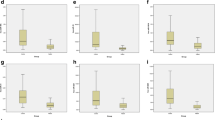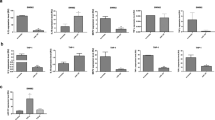Abstract
Aim
microRNAs (miRNAs) are small noncoding RNAs that play critical roles in physiological networks by regulating host genome expression at the post-transcriptional level. miRNAs are known to be key regulators of various biological processes in different types of immune cells, and they are known to regulate immunological functions. Differential expression of miRNAs has been documented in several diseases, including autoinflammatory and autoimmune diseases. This review aimed to focus on miRNAs and their association with autoimmune and autoinflammatory diseases.
Methods
All related literature was screened from PubMed, and we discussed the possible role of miRNAs in disease prediction and usage as therapeutic agents from the perspective of Familial Mediterranean Fever (FMF).
Conclusions
FMF is an inherited autosomal recessive autoinflammatory disease caused by mutations in the MEditerranean FeVer (MEFV) gene, which encodes the protein pyrin. Recent studies have demonstrated that miRNAs may be effective in the pathogenesis of FMF and offer a potential explanation for phenotypic heterogeneity. Further understanding of the role of miRNAs in the pathogenesis of these diseases may help to identify molecular diagnostic markers, which may be important for the differential diagnosis of autoinflammatory diseases. Studies have shown that in the near future, traditional therapies in autoinflammatory diseases may be replaced with novel effective, miRNA-based therapies, such as the delivery of miRNA mimics or antagonists. These approaches may be important for predictive, preventive, and personalized medicine.

Similar content being viewed by others
References
Kumar M, Nath S, Prasad HK, Sharma G, Li Y. MicroRNAs: a new ray of hope for diabetes mellitus. Protein Cell. 2012;3(10):726–38.
Garzon R, Marcucci G, Croce CM. Targeting microRNAs in cancer: rationale, strategies and challenges. Nat Rev Drug Discov. 2010;9(10):775–89.
Kim VN, Han J, Siomi MC. Biogenesis of small RNAs in animals. Nat Rev Mol Cell Biol. 2009;10:126–39.
Turkish FMF Study Group. Familial Mediterranean fever in Turkey: results of a nationwide multicenter study. Medicine. 2005;84(1):1–11.
Manthiram K, Zhou Q, Aksentijevich I, Kastner DL. The monogenic autoinflammatory diseases define new pathways in human innate immunity and inflammation. Nat Immunol. 2017;18(8):832–42.
Ozen S, Batu ED. The myths we believed in familial Mediterranean fever: what have we learned in the past years? Semin Immunopathol. 2015;37:363–9.
Ozen S, Demirkaya E, Amaryan G, Kone-Paut I, Polat A, Woo P, et al. Results from a multicentre international registry of familial Mediterranean fever: impact of environment on the expression of a monogenic disease in children. Ann Rheum Dis. 2014;73(4):662–7.
Golubnitschaja O, Baban B, Boniolo G, Wang W, Bubnov R, Kapalla M, Krapfenbauer K, Mozaffari MS, Costigliola V. Medicine in the early twenty-first century: paradigm and anticipation—EPMA position paper 2016. EPMA J. 2016;7:23. https://doi.org/10.1186/s13167-016-0072-4.
Golubnitschaja O, Costigliola V. General report and recommendations in predictive, preventive and personalized medicine 2012: white paper of the European association for predictive, preventive and personalized medicine. EPMA J. 2012;3(1):14. https://doi.org/10.1186/1878-5085-3-14.
Krol J, Loedige I, Filipowicz W. The widespread regulation of microRNA biogenesis, function and degradation. Nat Rev Genet. 2010;11:597–610.
Valadi H, Ekström K, Bossios A, SjöstraNd M, Lee JJ, Lötvall JO. Exosome-mediated transfer of mRNAs and microRNAs is a novel mechanism of genetic exchange between cells. Nat Cell Biol. 2007;9:654–9.
Zhang Y, Liu D, Chen X, et al. Secreted monocytic miR-150 enhances targeted endothelial cell migration. Mol Cell. 2010;39:133–44.
Hergenreider E, Heydt S, Tréguer K, et al. Atheroprotective communication between endothelial cells and smooth muscle cells through miRNAs. Nat Cell Biol. 2012;14:249–56.
Adams BD, Parsons C, Walker L, Zhang WC, Slack FJ. Targeting noncoding RNAs in disease. J Clin Investig. 2017;127:761–71.
Shah MY, Ferrajoli A, Sood AK, Lopez-Berestein G, Calin GA. microRNA therapeutics in cancer—an emerging concept. EBioMedicine. 2016;12:34–42.
Molitoris JK, Mccoll KS, Distelhorst CW. Glucocorticoid-mediated repression of the oncogenic microRNA cluster miR-17 ~ 92 contributes to the induction of Bim and initiation of apoptosis. Mol Endocrinol. 2011;25:409–20.
Ueda R, Kohanbash G, Sasaki K, Fujita M, Zhu X, Kastenhuber ER, Mcdonald HA, Potter DM, Hamilton RL, Lotze MT, Khan SA, Sobol RW, Okada H. Dicer-regulated microRNAs 222 and 339 promote resistance of cancer cells to cytotoxic T-lymphocytes by down-regulation of ICAM-1. Proc Natl Acad Sci USA. 2009;106:10746–51.
Cortez MA, Ivan C, Valdecanas D, et al. PDL1 regulation by p53 via miR-34. J Natl Cancer Inst. 2016;108(1):1–9.
Lujambio A, Ropero S, Ballestar E, Fraga MF, Cerrato C, Setien F, Casado S, Suarez-Gauthier A, Sanchez-Cespedes M, Git A, Spiteri I, Das PP, Caldas C, Miska E, Esteller M. Genetic unmasking of an epigenetically silenced microRNA in human cancer cells. Cancer Res. 2007;67:1424–9.
Janssen HL, Reesink HW, Lawitz EJ, Zeuzem S, Rodriguez-Torres M, Patel K, Van Der Meer AJ, Patick AK, Chen A, Zhou Y, Persson R, King BD, Kauppinen S, Levin AA, Hodges MR. Treatment of HCV infection by targeting microRNA. N Engl J Med. 2013;368:1685–94.
Noren Hooten N, Fitzpatrick M, Wood WH, De S, Ejiogu N, Zhang Y, et al. Age-related changes in microRNA levels in serum. Aging (Albany, NY). 2013;5:725–40.
Doria A, Zen M, Bettio S, Gatto M, Bassi N, Nalotto N, Ghirardello A, Laccarino L, Punzi L. Autoinflammation and autoimmunity: bridging the divide. Autoimmune Rev. 2012;12(1):22–30. https://doi.org/10.1016/j.autrev.2012.07.018 (Epub 2012 Aug 2).
Nana-Sinkam SP, Croce CM. MicroRNA regulation of tumorigenesis, cancer progression and interpatient heterogeneity: towards clinical use. Genome Biol. 2014;15:445.
Boon RA, Dimmeler S. MicroRNAs in myocardial infarction. Nat Rev Cardiol. 2015;12:135–42.
Issler O, Chen A. Determining the role of microRNAs in psychiatric disorders. Nat Rev Neurosci. 2015;16:201–12.
Liao Q, Wang B, Li X, Jiang G. miRNAs in acute myeloid leukemia. Oncotarget. 2017;8:3666–82.
O’Connell RM, Rao DS, Baltimore D. MicroRNA regulation of inflammatory responses. Annu Rev Immunol. 2012;30:295–312.
Lindsay MA. microRNAs and the immune response. Trends Immunol. 2008;29(7):343–51.
Wang S, Wan X, Ruan Q. The microRNA-21 in autoimmune diseases. Int J Mol Sci. 2016;17(6):864.
Singh RP, Massachi I, Manickavel S, Singh S, Rao NP, Hasan S, et al. The role of miRNA in inflammation and autoimmunity. Autoimmun Rev. 2013;12:1160–5.
Perez-HernaNdez J, Forner MJ, Pinto C, Chaves FJ, Cortes R, Redon J. Increased urinary exosomal microRNAs in patients with systemic lupus erythematosus. PLoS One. 2015;10:e0138618.
Wu M, Barnard J, Kundu S, McCrae KR. A novel pathway of cellular activation mediated by antiphospholipid antibody induced extracellular vesicles. J Thromb Haemost. 2015;13:1928–40.
Lucherini OM, Obici L, Ferracin M, Fulci V, McDermott MF, Merlini G, et al. First report of circulating microRNAs in tumour necrosis factor receptor-associated periodic syndrome (TRAPS). PLoS One. 2013;8:e73443.
Bauernfeind F, Rieger A, Schildberg FA, Knolle PA, Schmid-Burgk JL, Hornung V. NLRP3 inflammasome activity is negatively controlled by miR-223. J Immunol. 2012;189(8):4175–81.
Puccetti A, Pelosi A, Fiore PF, Patuzzo G, Lunardi C, Dolcino M. MicroRNA expression profiling in Behcet’s disease. J Immunol Res. 2018;2018:2405150.
Qingyun Z, Xiang X, Chaokui W, Xuedong Z, Fuzhen L, Yan Z, et al. Decreased microRNA-155 expression in ocular Behcet’s disease but not in Vogt Koyanagi Harada Syndrome. Investig Ophthalmol Vis Sci. 2012;53(9):5665–74.
Aubert P, Suárez-Fariñas M, Mitsui H, Johnson-Huang LM, Harden JL, Pierson KC, et al. Homeostatic tissue responses in skin biopsies from NOMID patients with constitutive over production of IL-1β. PLoS One. 2012;7:e49408. https://doi.org/10.1371/journal.pone.
International FMF Consortium. Ancient missense mutations in a new number of the Roret gene family cause familial Mediterranean fever. Cell. 1997;90:797–807.
French FMF Consortium. A candidate gene for familial Mediterranean fever. Nat Genet. 1997;17(1):25–31.
Camus D, Shinar Y, Aamar S, Langevitz P, Ben-Zvi I, Livneh A, et al. ‘Silent’ carriage of two familial Mediterranean fever gene mutations in large families with only a single identified patient. Clin Genet. 2012;82(3):288–91.
Wada T, Toma T, Matsuda Y. Microarray analysis of circulating microRNAs in familial Mediterranean fever. Mod Rheumatol. 2017;6:1–18.
Latsoudis H, Mashreghi MF, Grün JR. Differential expression of miR-4520a associated with pyrin mutations in Familial Mediterranean fever (FMF). J Cell Physiol. 2017;232(6):1326–36.
Amarilyo G, Pillar N, Ben-Zvi I, Weissglas-Volkov D, Zalcman J. Analysis of microRNAs in familial Mediterranean fever. PLoS One. 2018;13(5):e0197829.
Hortu HO, Karaca E, Sozeri B, Gulez N, Makay B, Gunduz C, et al. Evaluation of the effects of miRNAs in familial Mediterranean fever. Clin Rheumatol. 2018. https://doi.org/10.1007/s10067-017-3914-0 (Epub ahead of print).
Koga T, Migita K, Sato T, Sato S, Umeda M, Nonaka F, et al. MicroRNA-204-3p inhibits lipopolysaccharide-induced cytokines in familial Mediterranean fever via the phosphoinositide 3-kinase γ pathway. Rheumatology (Oxford). 2018;57(4):718–26.
Akkaya-Ulum YZ, Balci-Peynircioglu B, Karadag O, Eroglu FK, Kalyoncu U, Kiraz S, et al. Alteration of the microRNA expression profile in familial Mediterranean fever patients. Clin Exp Rheumatol. 2017;108(6):90–4 (35 Suppl).
Suraweera A, O’Byrne KJ, Richard DJ. Combination therapy with histone deacetylase inhibitors (HDACi) for the treatment of cancer: achieving the full therapeutic potential of HDACi. Front Oncol. 2018;8:92.
Merhautova J, Demlova R, Slaby O. MicroRNA-based therapy in animal models of selected gastrointestinal cancers. Front Pharmacol. 2016;7:329.
Wu R, Zeng J, Yuan J, et al. MicroRNA-210 overexpression promotes psoriasis-like inflammation by inducing Th1 and Th17 cell differentiation. J Clin Investig. 2018;128(6):2551–68.
Talebi F, Ghorbani S, Chan WF, et al. MicroRNA-142 regulates inflammation and T cell differentiation in an animal model of multiple sclerosis. J Neuroinflammation. 2017;14(1):55.
Pal AS, Kasinski AL. Animal models to study microRNA function. Adv Cancer Res. 2017;135:53–118.
Ciniselli CM, Lecchi M, Gariboldi M, Verderio P, Daidone MG. Workflow for circulating miRNA identification and development in cancer research: methodological considerations. In: Deigner HP, Kohl M, editors. Precision medicine: tools and quantitative approaches. London: Elsevier/Academic Press; 2018. p. 103–16.
Dai R, Ahmed SA. microRNA, a new paradigm for understanding immunoregulation, inflammation, and autoimmune diseases. Transl Res J Lab Clin Med. 2011;157(4):163–79.
Acknowledgements
This work was supported by Technical and Scientific Research Council of Turkey [TUBITAK], Grant number: 214S106 and Hacettepe University, Scientific Research Projects Coordination Unit, Grant number: 013D05101005.
Author information
Authors and Affiliations
Corresponding author
Ethics declarations
Conflict of interest
The authors have no conflicting financial, personal, or professional interest to disclose.
Statement of informed consent
Patients have not been involved in the study.
Statement of human and animal rights
No experiments have been performed, including experiments with patients and/or animals.
Additional information
Responsible Editor: John Di Battista.
Publisher's Note
Springer Nature remains neutral with regard to jurisdictional claims in published maps and institutional affiliations.
Rights and permissions
About this article
Cite this article
Balci-Peynircioglu, B., Akkaya-Ulum, Y.Z., Akbaba, T.H. et al. Potential of miRNAs to predict and treat inflammation from the perspective of Familial Mediterranean Fever. Inflamm. Res. 68, 905–913 (2019). https://doi.org/10.1007/s00011-019-01272-6
Received:
Accepted:
Published:
Issue Date:
DOI: https://doi.org/10.1007/s00011-019-01272-6




